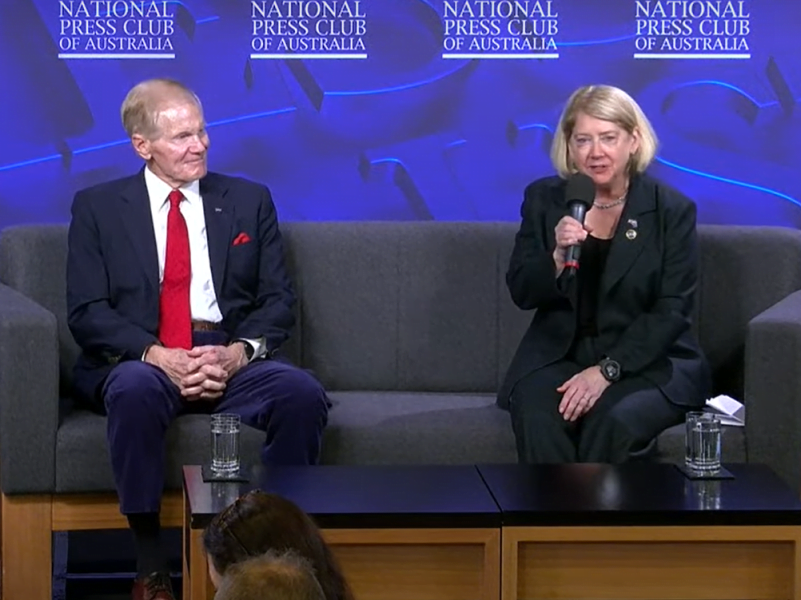Australian rockets and wider launch capabilities would build resilience for the United States’ and Australian space sectors according to NASA’s leaders, who also advocated for government support for developing the space industry.
In their address to the National Press Club on Thursday, NASA administrator Senator Bill Nelson and deputy administrator Colonel (retired) Pamela Melroy reiterated the importance international space collaboration, as well as that of public-private partnerships.
Australia is a signatory to the United States-led Artemis accords which outlines guiding principles for peaceful and collaborative space exploration. Australian firms are also participating in NASA’s Artemis mission to return US astronauts to the moon by 2024.

Coinciding with the NASA administrators’ historic visit to Australia, two Australian space industry consortiums were announced on Monday to partner with NASA to deliver semi-autonomous Rovers for NASA’s Trailblazer program, part of the Moon to Mars mission. It is expected to launch in 2026.
In response to questions from InnovationAus.com, Colonel Melroy noted that sharing launch capabilities between Australia and the United States would create greater resilience, highlighting NASA’s shared agreements with the European Space Agency as an example.
“Having partners who have launch capability we found enhances our resilience. Sometimes [the European Space Agency (ESA) builds] a satellite and we put an instrument on it and they launch it. Sometimes we build a satellite, and they put an instrument on it and we launch it and even the James Webb Space Telescope was too large to fit on any of the rockets that were available at the time. So we worked out a partnership with ESA and they nailed it.”
Senator Nelson added that Australian launch capabilities could be deployed in future NASA-led missions, in a response to questions from InnovationAus.com.
“Your question in essence for me is, is there room now for Australian rockets, and an Australian space contribution? And indeed, the answer is yes. We’ve seen for example, [NASA’s Capstone CubeSat] … was launched from New Zealand,” Senator Nelson said.
“There is such a vast opportunity, economic opportunity for businesses in a space-based economy as we improve our technologies that there’s going to be room for many, many. So the answer is yes.”
Senator Nelson also said he wants to see an Australian astronaut train and fly on a NASA-led mission to help deepen cooperation between Australian and the US.
NASA’s administrators also told InnovationAus.com that the Australia-US Technology Safeguarding Agreement, which has been in the works over the last year and a half, is “tremendously important” to expanding the space industries of both countries.
Senator Nelson remarked “what better time than to do it right now”, to complement ongoing development of the AUKUS agreement.
“You’re going to have additional new technologies and a new, highly educated and technological workforce. That is as a result of that agreement. Why not have the parallel development of a space economy?”
Last year the ANU National Security College published a policy options paper by Philip Citowicki, who was the Space Industry Association of Australia director of operations and at US think tank Pacific Forum at the time, that called for the Australia-US Technology Safeguarding Agreement to be accelerated.
This would “enable US commercial space companies to operate from Australian spaceports and export space launch technology”. It also called for the Space sector to be formally considered a part of the technology transfer pillar of AUKUS.
Colonel Melroy also told journalists it is “very important” for governments to support development of the space economy.
During her speech, she highlighted that innovation in the space sector can “lift across multiple areas”, offering the small cameras used in smartphones as an example, and that NASA directed investments has generated a 3:1 return to the US economy.
She said that public investment in “Australia is well poised” to develop “national capabilities spun very rapidly off into a commercial industry”.
The remarks follow the recommendation from the Senate Economic Legislative Committee that the space sector be eligible for funding through the Albanese government’s proposed $15 billion National Reconstruction Fund. This came amid industry concerns that the sector had been overlooked when compared to the former Coalition government, who selected space as one of its national manufacturing priorites.
Colonel Melroy outlined NASA’s approach to private-public partnership but prefaced that “it’s not one size fits all”. In particular, she praised the “very strong robotics capability” developed in Australia.
“If we believe there is a true commercial market for capability, launch would be a great example for that…well understood business model around that, we can invest and partner on the technical capability that we need, but then take advantage of economies of scale. When there’s other customers, it brings the price down for everybody, and in space those economies are significant,” Colonel Melroy said.
“But in some cases, for example, a Mars transport vehicle, probably not a near term commercial market for that, so we’ll make that investment from the beginning. We will partner with industry, but we’ll drive it to our requirements, not just step back and let someone innovate around it, well we’d like to get innovation, but I think we’ll be driving the requirements on that.
“But it is really critical that the government understands their industry partner when they make those decisions, and they understand how to incentivise both the government and industry to work together effectively. We’re pretty proud of how we’ve done that for commercial crew and cargo. We’ve learned a lot from it, and we’re happy to share.”
NASA’s Commerical Crew and Cargo Program signed $800 million worth of agreements with the US space industry for commercial cargo transportation demonstrations and a further $50 million in commercial crew development activities.
Colonel Melroy credits the program for enabling the private sector to develop low cost access to space and ending the innovation “death spiral” in the space sector.
Do you know more? Contact James Riley via Email.

